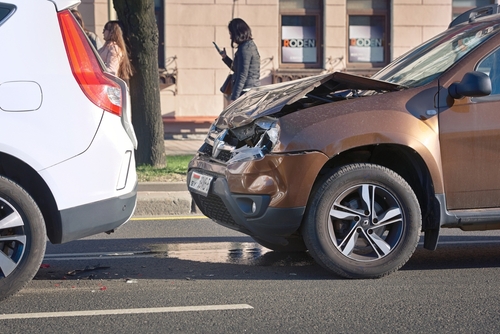Rear-end collisions are among the most common car accidents. Whether you’re driving on Denver’s busy streets, winding through mountain passes, or commuting on I-25, you face an ever-present risk of a rear-end collision.
These accidents can result in serious injuries, substantial property damage, and the need to involve a Colorado car accident lawyer.
Rear-End Collision Guide
-
- Understanding Rear-End Collisions
- The Day After a Rear-End Collision: What to Do Next
- Colorado’s Fault System and How It Affects Your Claim
- Common Injuries in Rear-End Collisions
- Long-Term Impact of Rear-End Collision Injuries
- Potential Compensation in a Rear-End Collision Case
- The Statute of Limitations in Colorado
- Why You Need an Experienced Car Accident Attorney
- Adapting to Colorado’s Unique Driving Challenges
- Get Your Free Consultation with a Car Accident Lawyer Today
Understanding Rear-End Collisions
Rear-end collisions occur when one vehicle crashes into the back of another. These accidents are alarmingly common across the nation. While state-specific data varies, national statistics from the National Highway Traffic Safety Administration (NHTSA) highlight the prevalence of these accidents.
In a recent year, rear-end collisions accounted for 32.5% of all motor vehicle crashes. These accidents cause significant property damage and result in a substantial number of injuries and fatalities.
Rear-end collisions can happen for many reasons, including:
- Distracted driving (e.g., texting, eating, or adjusting the radio)
- Tailgating
- Sudden stops
- Poor road conditions
- Impaired driving
- Mechanical failures
The Day After a Rear-End Collision: What to Do Next
After a rear-end collision, you might feel unsure about what to do next. Here’s a quick list to help you:
1. Seek Medical Attention if You Haven’t Already
Even if you feel fine after the accident, you should still talk to a doctor. Some injuries may not show symptoms immediately.
2. Report the Accident if You Haven’t Done So
If you didn’t report the accident to the police at the scene, do so now. In Colorado, you must report any accident resulting in injury, death, or property damage. While it’s best to have a police report from the scene, filing a report the next day is better than not reporting at all.
When speaking with the police:
- Stick to the facts
- Avoid admitting fault
- Mention any hazardous road conditions or circumstances that may have contributed to the accident
3. Document Everything
If you could not gather all the necessary information at the scene, do your best to document everything now:
- Take photos of any visible injuries and vehicle damage
- Write down your recollection of the accident while it’s fresh in your mind
- If you remember seeing any witnesses, try to track down their contact information
- Note the exact location, date, and time of the accident
4. Notify Your Insurance Company
Report the accident to your insurance company as soon as possible. Stick to the facts and avoid admitting fault. Remember, Colorado is an at-fault state, which means the insurance company of the driver responsible for the accident must pay for damages.
5. Start a Journal
Begin keeping a daily journal about how your injuries are affecting your life. Note any pain, discomfort, sleep disturbances, or activities you can’t perform due to your injuries. You need this documentation to prove pain and suffering.
6. Gather Your Documents
Collect and organize all relevant documents, including:
- Medical records and bills
- The police report (or the report number if you don’t have a copy yet)
- Insurance information for all parties involved
- Photos from the accident scene and of your injuries
- Any receipts for expenses related to the accident (e.g., towing fees, medication)
7. Communicate Cautiously
The other driver’s insurance company may try to contact you. Be very careful
about what you say. It’s often best to avoid giving a statement until you’ve
consulted with an attorney.
8. Contact an Experienced Car Accident Attorney
Consult a knowledgeable Colorado car accident lawyer before you speak further with any insurance companies or consider any settlement offers.
At Franklin D. Azar & Associates, P.C., we can:
- Evaluate the strength of your case
- Talk about the potential value of your claim
- Handle communication with insurance companies on your behalf
- Make sure you meet all legal deadlines
- Fight for the compensation you need
Colorado’s Fault System and How It Affects Your Claim
Unlike some states that follow a no-fault system, Colorado operates under a fault-based system for car accidents. This means that the person responsible for causing the accident is also responsible for the resulting damages. In rear-end collisions, the rear driver is often presumed to be at fault, but this isn’t always true.
Colorado follows a modified comparative negligence rule. Under this system, you can recover damages if you’re less than 50% at fault for the accident. However, your compensation will decrease by the percentage of your fault.
Common Injuries in Rear-End Collisions
Rear-end collisions can result in a wide range of injuries, some of which may not immediately manifest.
Common injuries include:
- Whiplash: A neck injury caused by the sudden jerking motion of the head and neck
- Neck and back injuries: Including herniated discs, sprains, and strains
- Spinal cord injuries: These can lead to partial or complete paralysis
- Traumatic brain injuries: Including concussions and more severe forms of brain trauma
- Facial injuries from airbag deployment: Such as burns, bruises, or fractures
- Broken bones: Particularly in the arms, wrists, or ribs
- Soft tissue injuries: Damage to muscles, ligaments, and tendons
Some injuries may take days or weeks to manifest symptoms, and early diagnosis and treatment can insure your recovery and legal claim.
Long-Term Impact of Rear-End Collision Injuries
While some injuries from rear-end collisions heal quickly, others can have long-lasting effects:
- Chronic pain: Particularly in the neck and back
- Reduced mobility: This can affect your ability to work or enjoy daily activities
- Psychological trauma: Including anxiety, depression, or PTSD related to driving
- Cognitive impairments: From traumatic brain injuries
- Financial strain: Due to ongoing medical treatments and lost wages
Understanding the potential long-term consequences plays into considering settlement offers or pursuing legal action.
Potential Compensation in a Rear-End Collision Case
You may recover different types of compensation after a rear-end collision, including:
- Medical expenses (past and future): This covers all necessary medical treatment related to your injuries
- Lost wages and loss of earning capacity: If your injuries affect your ability to work, either temporarily or permanently
- Property damage: Costs to repair or replace your vehicle and any other damaged property
- Pain and suffering: Compensation for physical pain and emotional distress
The Statute of Limitations in Colorado
In Colorado, you generally have three years from the accident date to file a lawsuit for personal injury or property damage resulting from a car accident. This may seem like a long time, but building a strong case takes time. Start the process as soon as possible to avoid missing this deadline.
Some exceptions apply to this rule:
- If the accident resulted in a death, the statute of limitations for a wrongful death claim is two years.
- If a government entity is involved, you may have to file a notice of claim within 182 days.
- For minors, the statute of limitations may toll (pause) until they reach the age of 18.
Why You Need an Experienced Car Accident Attorney
Picking up the pieces after a rear-end collision can overwhelm you, especially when you’re dealing with injuries and trying to recover.
An experienced car accident attorney can:
- Investigate the accident thoroughly: This includes obtaining police reports, interviewing witnesses, and potentially hiring accident reconstruction experts
- Gather and preserve evidence: Confirming that all necessary documentation is collected and properly maintained
- Handle all communication with insurance companies: Protecting you from potentially damaging statements
- Accurately calculate the full extent of your damages: Including future medical expenses and long-term impacts
- Negotiate for a fair settlement: Using their knowledge of the law and similar cases to argue for appropriate compensation
- Take your case to trial if necessary: If the other side refuses a fair settlement, your attorney will be prepared to present your case in court
At Franklin D. Azar & Associates, P.C., we have decades of experience helping Colorado residents get the compensation they deserve after a car accident. We understand the law and how to build strong cases that get results.
Adapting to Colorado’s Unique Driving Challenges
As a driver in Colorado, it’s the driver’s responsibility to adapt to the state’s unique geography and climate. These conditions can increase the risk of rear-end collisions, but a driver can navigate them safely with proper preparation.
1. Mountain Driving
Steep grades and winding roads in Colorado’s mountainous regions.
Drivers Responsibility:
- Increase following distance on mountain roads, especially on descents.
- Use lower gears when descending to reduce strain on the brakes.
- Stay in the right lane unless passing, allowing faster traffic to move freely.
- Be cautious on notorious mountain passes like Loveland Pass or Wolf Creek Pass.
2. Rapidly Changing Weather
Colorado’s weather can change quickly, from sudden snowstorms to intense sun glare.
Drivers Responsibility:
- Always check the weather forecast before traveling, especially in winter.
- Carry appropriate equipment such as snow chains or snow tires during winter months.
- Reduce speed and increase following distance in adverse weather conditions.
- Clean the windshield regularly to reduce glare and improve visibility.
3. Wildlife Encounters
In rural areas, sudden animal crossings can lead to abrupt stops and potential rear-end collisions.
Drivers Responsibility:
- Stay alert, especially during dawn and dusk when animals are most active.
- Reduce speed in areas known for wildlife, such as Rocky Mountain National Park.
- If you spot an animal, slow down and be prepared to stop, but avoid swerving dangerously.
- Use high beams when possible to increase visibility.
4. High-Altitude Driving
At higher elevations, some drivers may experience fatigue or decreased reaction times.
Drivers Responsibility:
- If drivers are not accustomed to high-altitude driving, they should plan for breaks.
- Stay hydrated and be aware of signs of altitude sickness.
- Maintain the vehicle is in good condition, as high altitudes can affect vehicle performance.
- Prepare for rapid weather changes, which are more common at high altitudes.
5. Urban Traffic Congestion
Cities like Denver, Colorado Springs, and Boulder can experience significant traffic congestion, increasing the risk of rear-end collisions.
Drivers Responsibility:
- Leave plenty of space between vehicles.
- Stay alert in stop-and-go traffic, avoiding distractions like cell phone use.
- Plan the route to avoid the most congested areas during peak hours.
- Use traffic apps to stay informed about current conditions and potential delays.
While Colorado’s diverse landscape and climate create unique driving challenges, it’s ultimately the driver’s responsibility to adapt to these conditions.
Franklin D. Azar & Associates, P.C. is here to help if you are involved in a rear-end collision. Our experienced team understands the unique aspects of Colorado driving and how they can factor into accident cases.
Get Your Free Consultation with a Car Accident Lawyer Today
Don’t try to handle the aftermath of a rear-end collision alone. The experienced Colorado car accident lawyer is here to help you every step of the way.
Remember, your focus should be on recovery. Let us handle the legal side while you concentrate on returning to your everyday life. Contact us today for your free consultation, and let us put our experience to work for you.




